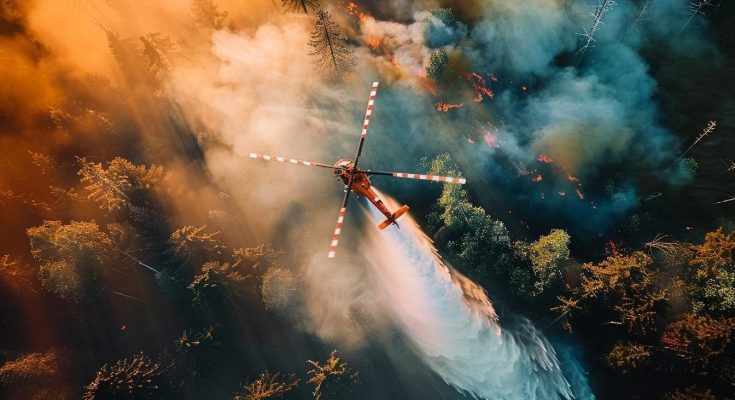Whether in Canada, California or around the Mediterranean—forest fires are becoming more frequent and, above all, more severe around the world. Especially in summer, heat, drought and wind often turn such fires into raging infernos, and the climate crisis is certainly not helping.
Researchers at the Fraunhofer Institute for High-Speed Dynamics, Ernst-Mach-Institut, EMI, and start-up CAURUS Technologies GmbH are responding to the increasing global threat. Together, they are developing an innovative extinguishing method that can be used to fight large-scale fires more efficiently from the air.
Climate change is altering the quality of forest fires, which are getting hotter and spreading faster. In Canada alone, an area of around 185,000 km2—slightly larger than the size of Greece and Switzerland combined—caught fire in 2023.
Germany is also seeing its forest fire season start earlier and earlier. In dry regions such as Brandenburg, the first hectares of forest fire were reported as early as March 1 this year.
Working closely with their partner CAURUS Technologies GmbH, researchers at Fraunhofer EMI are seeking to make a key contribution to fighting forest fires from the air with a new type of extinguishing method. The modular system consists of hardware and software and combines digital technology with innovative extinguishing approaches to complement conventional extinguishing methods.
Generating a targeted water-aerosol cloud to improve the extinguishing effect
Most of the airborne firefighting technology we use today dates back to the 1970/80s. Helicopters or airplanes carrying buckets of extinguishing water fly over the burning forests. At an altitude of 40 to 50 meters, the pilots open the bottom of the bucket. However, the water is usually blown away and distributed over a large area by winds and thermals.
As a result, only a small amount of the extinguishing water actually ends up in the flames.
“We are able to offer fire departments improved and more sustainable extinguishing methods and use digital control options to enhance the precision with which the extinguishing water is deployed,” explains Dr. Dirk Schaffner, a researcher at Fraunhofer EMI in Freiburg.
The project partners are also developing an opening mechanism that produces an extinguishing cloud that is significantly more efficient. This enables the pilots to release very small, fine water droplets and to position the extinguishing cloud precisely and close to the source of the fire.
These factors have a decisive influence on the success of suppression. They help to quickly reduce the temperature of the fire, bringing it below the ignition point, and deprive the fire of the oxygen it needs over a wide area.
“The mechanism enables us to generate a targeted water-aerosol cloud, which is activated at a height of a few meters above or even in the flames. The water is not dispersed beforehand but held together in a bag until it is just above the fire. Almost 100% of the water lands directly in the flames,” describes Dr. Schaffner.
The water-aerosol cloud removes the heat from the fire very quickly.
“The heat transfer rate at which energy can be removed from a system depends on the surface area. The larger the surface area of the absorbing medium, the faster the heat energy is transferred from the burning medium to the absorbing medium. And the aerosol cloud has an extremely large surface area,” explains the researcher.
He adds that a significantly higher heat transfer rate is achieved with an aerosol cloud than with a block of water. The method is also very efficient at displacing oxygen, causing the combustion process to weaken.
The researchers are focusing in particular on ensuring that their solution is compatible with existing, successful extinguishing tactics carried out on the ground and on keeping all emergency service personnel safe.
Increasing the efficiency of water
The new technology—the aerosolization of water—is already being used in high-pressure dispersion nozzles by firefighters on the ground. Researchers at Fraunhofer EMI and CAURUS Technologies GmbH are now applying it in the air for the first time, thereby significantly expanding the range of applications.
Based on their studies, the project partners expect the extinguishing effect to be five to ten times greater than that of current systems.
“For every liter of water used, the new method is capable of extinguishing a fire that is five to ten times larger,” says Dr. Schaffner, emphasizing a key advantage of the technology, given that worldwide water resources are increasingly scarce.
The safety of emergency service personnel is also ensured, as they do not have to fly unnecessarily close to the source of the fire and can maintain greater dropping distances. What’s more, the new extinguishing method helps to reduce CO2 emissions, as vegetation fires are contained much more quickly.
Forest fires are an immense source of CO2 emissions—on average, 6.9 gigatons of CO2 emissions have been released by forest fires every year over the last 20 years. This is more than twice as much as the emissions produced by all 27 members of the European Union in the same period.
The project partners have successfully tested the first prototypes of their innovative extinguishing method and are currently working on a demonstrator.
Provided by Fraunhofer-Gesellschaft





